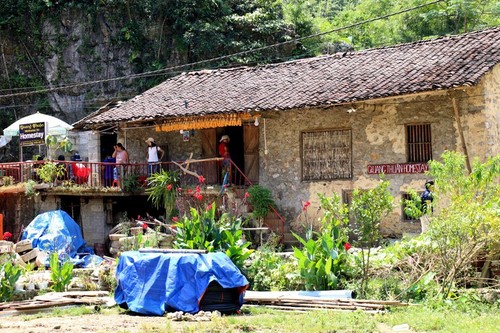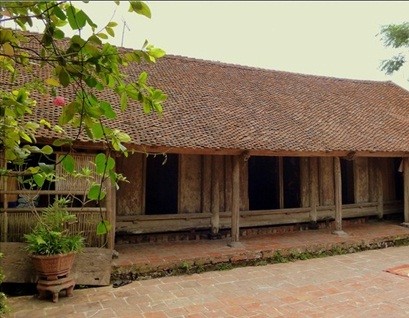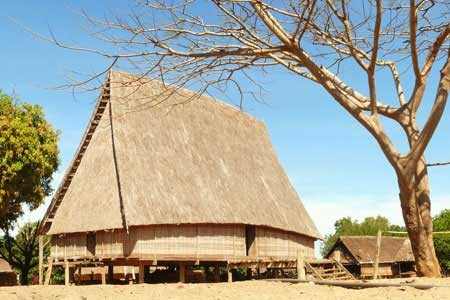 Rock house of the Tay in Vietnam's northern region Rock house of the Tay in Vietnam's northern region |
A: First on our show today, we’d like to acknowledge a letter from Grant Skinner of the UK, a long time listener to VOV.
B: In a letter dated October 10, Mr. Skinner reported reception of a program on the frequency of 7280 khz with SINPO of 45444. He wrote: “the signal wasn’t bad despite some crackles, sometimes the broadcast went downhill because of the crackles. Thank you for sending me a keyring and a 3D basket of flowers. I really appreciate them.”
B: Thank you, Mr. Skinner, for your regular reports on our program. We look forward to receiving more feedback from you.
A: This week, Amena Khanam Sale of Bangladesh sent us a reception report for a program on November 4 on the frequency of 7220 khz, saying the signal was strong. He said he liked the story about VOV Journalist Tran Thien Nhien, who worked for VOV for more than 24 years and was prolific with reports, commentaries, and radio chronicles that traced Vietnam’s development in both war time and peace time.
B: He also said he wants to learn more about traditional houses in Vietnam.
A: A house to a Vietnamese is more than a just place to live. It’s where one’s childhood memories dwell, where we find peace and happiness with our loved ones, and it’s a foundation on which to build our future.
 Traditional house of the Kinh people in Vietnam's Red River Delta Traditional house of the Kinh people in Vietnam's Red River Delta |
B: Vietnam has a centuries-old agriculture culture which rests on a system of self-sufficient villages. Unlike nomads, farmers value their houses more than anything else. Farmers live under a roof, store grain and tools inside their house, give birth to children and raise them in a house. The house is where weddings, funerals and feasts take place and contains the ancestral altar where all worshiping and rituals are performed. House is not just a place, it’s the soul of the Vietnamese people.
A: Vietnam has 54 ethnic groups and each has its own culture, traditions, and house architectural style. In the Red River Delta, Kinh people consider building a house the most important project of one’s lifetime.
B: The Kinh people have developed an architecture that is nature-friendly. A traditional Kinh house consists of one main house, one or more wing houses, a garden, a fish pond, a poultry and cattle yard, a drying yard, and a fence with a gate.
A: The main house is the most important structure . It usually has 3 rooms. The three central rooms are for the ancestral altar, for welcoming guests, and for the owner’s bedrooms. The wife and children sleep in the wing-houses. The central room is the “face” of the house and therefore is decorated very carefully. The wing houses are for sleeping and storing tools, rice and other things. One wing house also contains the kitchen.
B: Stilt houses made of rocks are typical of the Tay ethnic people in Vietnam’s northern mountains. The Tay believe that rocks are the source of life and the center of the universe.
 Rock house of the Tay in northern Vietnam Rock house of the Tay in northern Vietnam |
A: Tay people build their rock stilt houses with two floors, the lower floor for livestock and the upper floor for humans. Tay houses are surrounded by rock fences. A rock stilt house takes two to three years to complete. Choosing beautiful rocks with which to build their house is a spiritual matter. They believe rocks, formed deep in the earth, embody the essence of heaven and earth and have a high spiritual energy.
B: One advantage of rock houses is that they are warm in the winter and cool in the summer. The location of the house is carefully considered. It should be on high ground near the foot of a mountain looking onto a wide, open space. A house is usually seven to eight meters tall and topped with a “yin-yang” tile roof.
A: Stilt houses can be found in every highland province in Vietnam. Suited to flood-prone plains as well as steep mountain slopes, these houses are popular with many of Vietnam’s 54 different ethnic groups.
 A Rong house of the Xo Dang in central highlands A Rong house of the Xo Dang in central highlands |
B: A Rong house is the traditional communal house of many ethnic minorities in the northern central highlands. A Rong house is built whenever a village is founded and all villagers must join in building the house. A special thing about the house is that visitors who come to the village must be able to see this house from any direction. The Rong house is the place where all village activities take place including festivals, meetings, ceremonies, and weddings. From the outside, the house is imposing with its giant yellow roof of dried gianh leaves supported by 8 big wooden pillars. Ba Na people decorate the Rong house with images of their Sun God.
A: We’ll talk more about traditional houses in later programs.
B: This week, Siddhartha Bhattacharjee of India sent us a reception report for the program from 16:00 to 16:30 UTC on November 11 on the frequency of 7220 khz and submitted an audio file of our radio broadcast. He asked about the weather monitoring system in Vietnam.
A: The Institute of Geophysics has built a modern monitoring system to collect input data for forecasting heavy rain and urban flooding in Hanoi. The system is part of a project called "Fostering Innovation through Research, Science and Technology" (FIRST), funded by the World Bank and managed by the Institute of Geophysics under the Ministry of Science and Technology.
B: The monitoring system includes two X-band radars, eight stations for measuring electric fields, two automated meteorological stations, ten automated stations for rainfall measurement, one unmanned aerial vehicle (UAV), one station for measuring cloud ceiling, eight satellite receivers and three lightning warning stations. These monitoring stations are all located in Hanoi’s outlying districts.
A: The Institute has also established an advanced warning system for heavy rain and urban flooding.
B: Shyamal Kumar Banerjee of India is one of many Indian listeners who want to know about trade ties between Vietnam and India.
A: The two-way trade between Vietnam and India is growing and is expected to hit 15 billion USD per year by 2020. Since the establishment of the Vietnam-India Comprehensive Strategic Partnership in 2016, bilateral trade revenue has increased from 7.8 billion USD to 12.8 billion USD. India is one of Vietnam’s 10 largest trading partners.
B: The two sides are working to approve the import of five Vietnamese fruits to India - blue dragons, longans, pomelos, rambutans and durians - and the export of three Indian crops to Vietnam - grapes, pomegranates, and millet.
A: Meat and fish products are India’s largest export items to Vietnam and electrical machinery and equipment are India’s main import items from Vietnam.
B: We’d like to thank you all for sending us feedback on our shortwave broadcasts and internet content. We’ll send you verification cards to confirm your reports.
A: We welcome your feedback at: English Service, VOVworld, the Voice of Vietnam, 45 Ba Trieu street, Hanoi, Vietnam. Or you can email us at englishsection@vov.org.vn. You’re invited to visit us online at vovworld.vn, where you can hear both live and recorded programs. Check out our VOV Media App, available on both the IOS and Android platform, to hear our live broadcasts. We look forward to your feedback on the mobile version of vovworld.vn. Once again, thank you all for listening. Goodbye until next time.